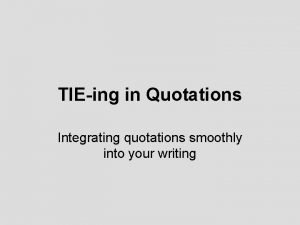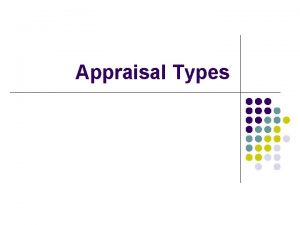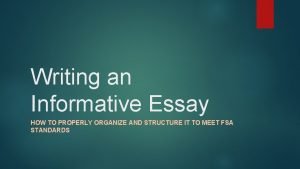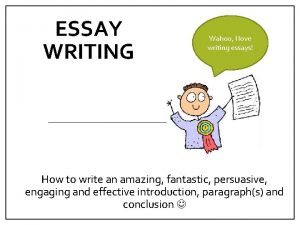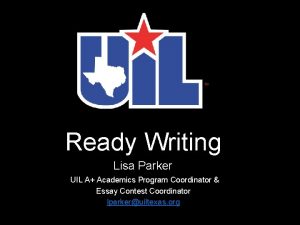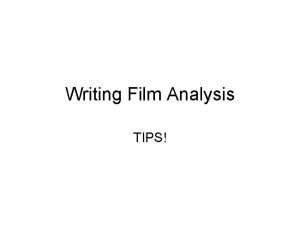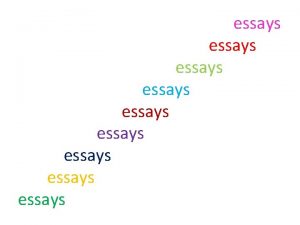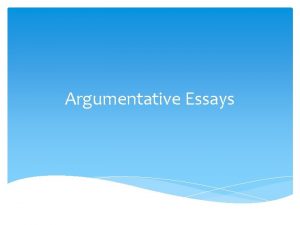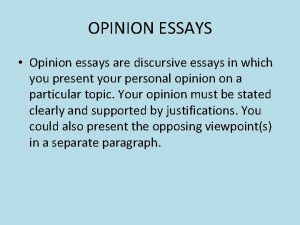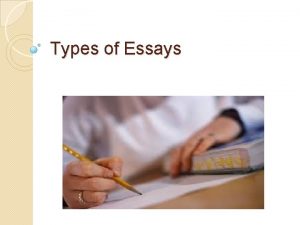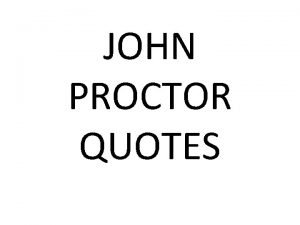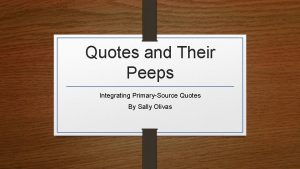Writing Effective Essays Integrating Quotes and Maintaining Critical
















- Slides: 16

Writing Effective Essays Integrating Quotes and Maintaining Critical Focus

Incorporating Textual Evidence into Your Literary Analysis One key to a good analytical paper is “staying close to the text” which means using quotes or textual evidence to support your main ideas. Here a few guidelines for using textual evidence correctly and effectively.

1. Never drop a quote. • Dropping a quote happens when there is no lead in whatsoever to frame the quote in the paper. • Instead provide clear connections between your quote and the text of your paper. • Always show the reader exactly how the example supports your thesis.

• Don’t trust your readers to figure out anything for themselves because they won’t! • See the typical reader; he needs your help. • Interpret your textual evidence; explain it; make connections; provide commentary. It’s YOUR job!

To Keep from dropping a quote: • Embed a key word or phrase from the novel into one of your own sentences. • Example: Simon gives his meat to Piggy and “lower[s] his face in shame, ” almost as if he is embarrassed to participate in this obscene parody of a sacrament. Note how the quote becomes an integral part of the text.

Another way to keep from dropping a quote: • Quote an entire sentence, but connect it to your text with a colon. • Example The church is foreboding to Jackie: “Within the old church was no stained glass; it was cold and dark and desolate, and…the trees knocked hollowly at the tall windows. ” • Be very cautious of overquoting. Choose your textual evidence for its power. If you overquote, your quotes will lose their effectiveness.

2. Never refer to your examples merely by their page numbers. • Don’t: On page 29 William Golding indicates the breakdown of society. • Use the actual words from the text. It’s your job to explain references by their content. • Otherwise you may madden your reader. “I want a quote!”

3. Don’t be obvious when introducing your quote. • Don’t use an expression so obvious as “As this quote shows…” or “The following quotation from the novel reveals…” • That is called “announcing your topic” and is substandard for analytical papers.

4. Remember that textual evidence is used to SUPPORT your ideas. If the evidence isn’t awesome support, choose something else!

5. Use the “heart” or “nugget” of the quote. • Cut out unnecessary parts of your quote to get to the most important part. • Indicate omitted words with ellipsis points …

6. Use brackets to alter the quote. • To match the tense of the quote to your paper, use brackets. See the example below: • Simon “lower[s] his face in shame” almost as if he is embarrassed to participate in this obscene parody of a sacrament. • You can also clarify a pronoun with brackets. • Brackets are to indicate changes you have made to the original wording for purposes of correctness or clarification.

How to Distinguish Critical Comments (Commentary) from Mere Plot Summary • To analyze, you need to maintain critical focus. • Start each body paragraph with a sentence that gives the reader an idea of where you are going critically with your paper. • Avoid using a mere fact from the work.

Note how to change a plot detail into a statement with critical focus. Plot detail: Jackson’s story opens on a balmy day. Critical comment: By setting her story on a balmy summer day, Jackson creates a false sense of well being. Plot detail: The oiler, who dies, was the strongest man in the boat. Critical comment: The oiler’s death is ironic because it upsets our expectations of survival of the fittest.

If you want to use both a critical observation and a plot detail in your topic sentence, be sure that the critical comment appears in the independent clause (because it is more important) and that the plot detail is place in the subordinate position. • Plot detail: Granny detests Cornelia’s blue lampshades. • Critical comment: One of Cornelia’s blue lampshades becomes the image of Granny’s diminishing spark of life. • Combined: Although Granny detests Cornelia’s blue lampshades, one of them becomes the image of her diminishing spark of life.

Another Example of Combining • Plot detail: The dog in “To Build a Fire” knows better than to go out in weather fifty below zero. • Critical comment: The dog serves as a foil for the foolish man in Jack London’s “To Build a Fire. ” • Combined: In Jack London’s “To Build a Fire, ” the dog, who knows better than to go out in weather fifty below zero, serves as a foil for the foolish men.

TO SUMMARIZE: STAY CLOSE TO THE TEXT! MAKE CONNECTIONS! MAINTAIN CRITICAL FOCUS! (COMMENTARY, COMMENTARY) AND DO YOUR JOB FOR THE READER!
 Critical semi critical and non critical instruments
Critical semi critical and non critical instruments Semicritical
Semicritical Maintaining effective partnerships
Maintaining effective partnerships Quotation acceptance form
Quotation acceptance form Embedded quotes mla examples
Embedded quotes mla examples Integrating quotes
Integrating quotes Critical incident essays
Critical incident essays Hook quotes for essays
Hook quotes for essays Quotes in essays examples
Quotes in essays examples How to start advantages and disadvantages essay
How to start advantages and disadvantages essay Paragraph writing
Paragraph writing How to write a thesis for an informative essay
How to write a thesis for an informative essay I love writing essays
I love writing essays Uil ready writing rubric
Uil ready writing rubric Critical reading meaning
Critical reading meaning 7 habits of highly effective teens quotes
7 habits of highly effective teens quotes The art of communication quotes
The art of communication quotes




